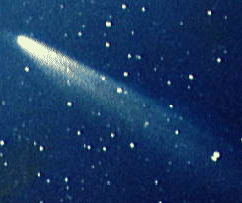 Those dirty snowballs and icy mudballs we call comets are water ice and frozen gases mixed with dust samples from the earliest history of our Solar System. Comets have been seen and reported since antiquity.
Those dirty snowballs and icy mudballs we call comets are water ice and frozen gases mixed with dust samples from the earliest history of our Solar System. Comets have been seen and reported since antiquity.
The Chinese recorded Comet Halley at least as far back as 240 BC. Commemorating the Norman Conquest of England in 1066, the famous Bayeux Tapestry carries a likeness of Comet Halley.
Nearly 900 comets have been cataloged with at least rough calculations of their orbits. Of those, 184 are listed as periodic comets which circle the Sun every so often, up to at least once every 200 years.
When comets are in the inner area of the Solar System, near the Sun, astronomers say they have these parts:
- nucleus, which is relatively solid and stable, mostly ice and gas with a small amount of dust,
- coma, which is a dense cloud of water, carbon dioxide and other gases boiled off of the nucleus by the Sun,
- hydrogen cloud, which is a very thin envelope millions of miles in diameter,
- dust tail of smoke-sized dust particles, millions of miles long, driven off the nucleus by escaping gases,
- ion tail of plasma laced with rays and streamers caused by interactions with the solar wind and tens of millions of miles long.